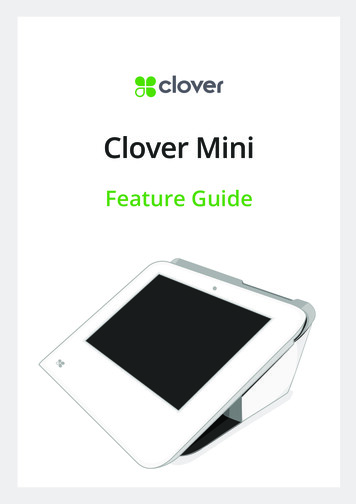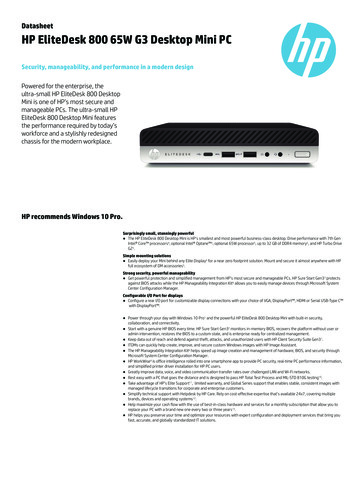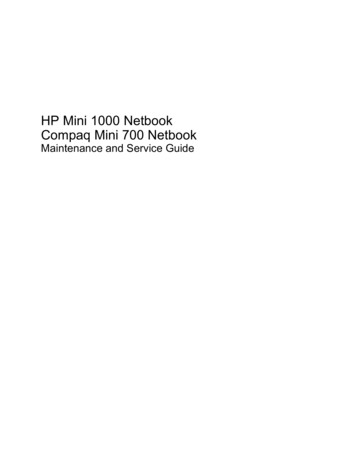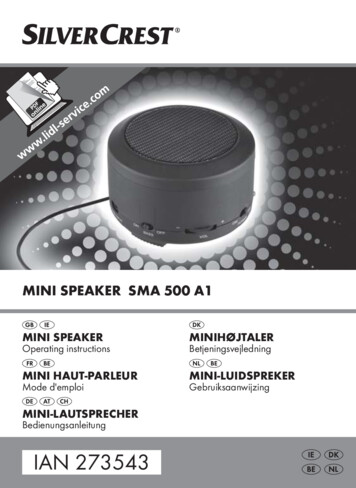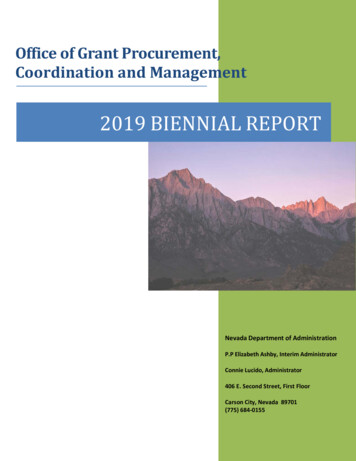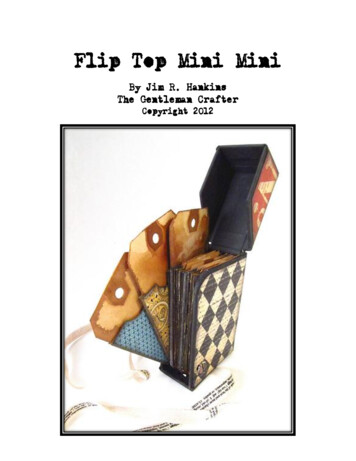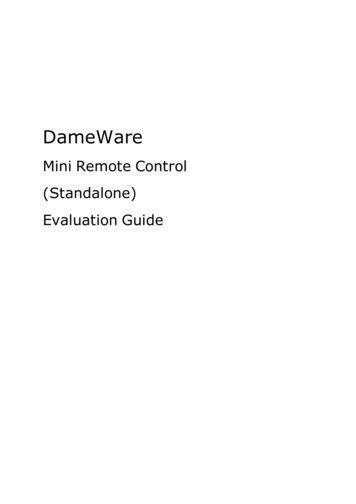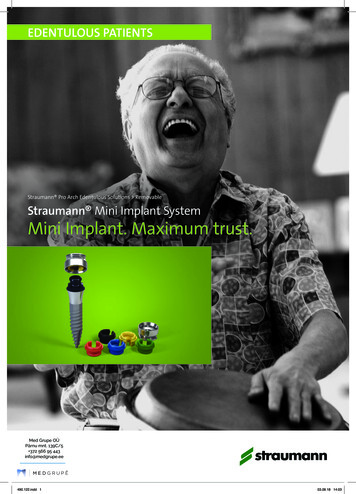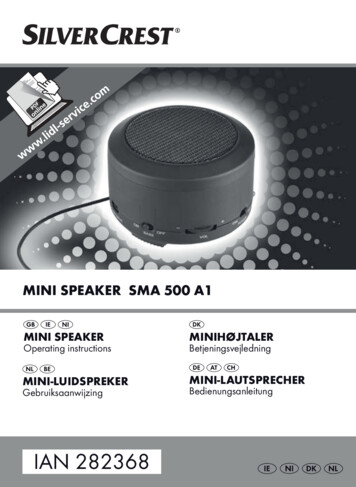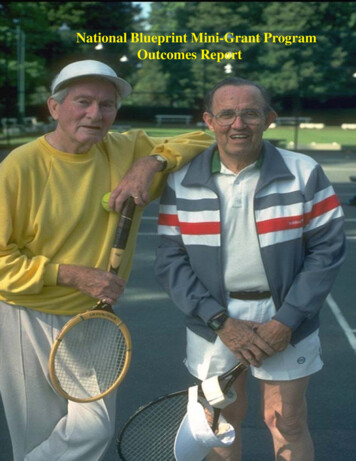
Transcription
National Blueprint Mini-Grant ProgramOutcomes Report
BACKGROUNDRegular physical activity provides significanthealth benefits for people of all ages andabilities. Although physical activity has beenwidely promoted for young people, researchshows that midlife and older adults too, benefitfrom physically active lifestyles. In fact,physical activity can prevent disease andpromote independence and well-being for ahealthier, more satisfying late life.Yet, despite the health benefits of physicalactivity, few older adults lead active lifestyles.Disseminating information about physicalactivity is insufficient to motivate older adultsto become more active. Numerous complexbarriers, such as safety and transportationissues, lack of guidance and guidelines forolder adults, health issues, and many otherobstacles prohibit many adults from increasingtheir physical activity levels.In 2001, nearly 50 of America’s top nationalorganizations that promote physical activityand health developed a National Blueprint toincrease physical activity among adults age50 and older. The National Blueprint outlinesbarriers to physical activity and manystrategies to eliminate these obstacles. Partnerorganizations also formed a unified coalitionwith a goal to influence participation levelsat every level of society by systematicallyaddressing physical activity and older adults.A national program office for the Blueprintcoalition was initiated at the University ofIllinois at Urbana-Champaign.
STRATEGIC PRIORITIESNational Blueprint partner organizations analyzed the barriers in the initial Blueprint andidentified 18 feasible, short-term priority strategies that could be implemented in the areas of homeand community, marketing, medical systems, research, and public policy. A few of the strategiesand accomplishments from 2003-2005 include the following:Identify professionals in the community who can serve as resources for information andassistance to programs and groups working in the area of physical activity.The American College of Sports Medicine developed a web-based directory of more than800 experts who can provide advice to individuals and groups with questions about aging andphysical activity. (ProFinder on ACSM website: www.acsm.org)Provide community organizations with a template for good physical activity programs.National Council on the Aging conducted a Best Practices in Physical Activity Programmingfor Older Adults competition. This effort resulted in a wealth of information regarding thedevelopment and maintenance of successful physical activity programs that can be used as atemplate for local organizations.Develop a national program that would provide incentives for communities to increase physicalactivity levels among the age 50 population.The Administration on Aging launched a national You Can! Steps to Healthier Agingcampaign providing a kit of activity guides and publicity templates to participating localorganizations. To date, the campaign has signed over 1,700 participants.Develop resources for clinicians to use in making personalized physical activityrecommendations/prescriptions for their patients.The American Geriatrics Society, the American Academy of Family Physicians, theAmerican College of Sports Medicine, the National Center on Physical Activity and Disability, andThera-Band Corporation developed an Active Aging Toolkit designed to help healthcare providersprescribe physical activity programs for their patients.Establish and provide technical assistance to national, regional, and local partnerships amonghealth, aging, urban/community planning, transportation, environmental, recreation, socialservice, and private sector organizations.The National Blueprint Office provided mini-grants to 20 local organizations/partnerships toprovide interventions for older adults.
NATIONAL BLUEPRINT MINI-GRANTSA key priority for the National Blueprint coalition is to support local partnerships amongcommunity organizations and private sector agencies in the areas of health, environment,transportation, and social services. In 2003, the Robert Wood Johnson Foundation provided fundingto the National Blueprint Office to award 20 mini-grants of up to 25,000 to community coalitionsacross the United States. Nearly 460 coalitions nationwide submitted proposals.A 13-member advisory committee of Blueprint partners reviewed the applications using a ratingsystem based on feasibility, sustainability, and overall impact. The committee was searching for localcommunity efforts designed to deliver physical activity interventions for adults age 50 and over thattarget culturally diverse audiences, promote intergenerational outreach, or address multi-level barriers.The committee selected 20 innovative programs in 16 states to provide physical activity interventionsfor a period of 15 months.The following pages describe the 20 programs’ goals, outcomes, impact, and sustainability.Many programs provide targeted interventions for specific segments of the older adult population, suchas minorities, low-income adults, or the frail elderly. Other programs provide an intergenerationalcomponent or creative incentives to motivate midlife and older adults to increase their physical activitylevels. All awarded programs have partnerships with local organizations and agencies to cost-shareprograms and promote sustainability. The 20 Mini-Grant programs can serve as models of bestpractices providing successful physical activity interventions for older adults in their communities.In total, the Mini-Grant programs reached nearly 10,000 adults age 50 and over.MINI-GRANT PROGRAMSArthritis Foundation, Maryland Chapter, Owings Mills, MDArthritis Foundation, New York Chapter, New York, NYBlue Cross and Blue Shield of Rhode Island, Providence, RICabarrus County Department of Aging, Concord, NCComprehensive Health Education Foundation, Seattle, WAEast Central Illinois Rural Health Network, Mattoon, ILFairfield University School of Nursing, Fairfield, CTGreater Lafayette Coalition for Living Well After 50, West Lafayette, INGreater Southern Brooklyn Health Coalition, Brooklyn, NYHarford County Office on Aging, Bel Air, MDHealth Research, Inc./ New York State Dept. of Health, Rensselaer, NYHennepin County, Minneapolis, MNHo-Chunk Nation Division of Health, Black River Falls, WIPalmetto Conservation Foundation, Spartanburg, SCPartners in Care Foundation, Burbank, CAPaterson YMCA, Paterson, NJSupporters of Doelger Senior Center, Daly City, CATerwilliger Plaza, Portland, ORTexas Cooperative Extension – Dallas County, Dallas, TXTufts Univerity, Center for Physical Activity and Nutrition, Boston, MA
Arthritis Foundation, Maryland ChapterPartners for Active LivingOwings Mills, MDProject OverviewThe Arthritis Foundation partnered with the Community Health Awareness and Monitoring Program(CHAMP) in 2002 to initiate the program, Health Freedom Walk: A Path to Wellness, in Baltimore City,MD, using Baltimore’s integral role in the Underground Railroad. Each year participants walk the 5-Kroute their ancestors traveled in a quest for freedom. Walking clubs were established in accessiblelocations throughout the city to help walkers train for the annual event. The Arthritis Foundation’s Walkwith EASE and People with Arthritis Can Exercise (PACE) programs were used for the project.Goals Increase the number of walkers participating in the 2004 Health Freedom Walk and increase thenumber of training sites. Offer PACE and CHAMP classes in new sites to give walkers additional physical activity options. Recruit volunteers and nurses through area churches to train as PACE leaders. Provide physicians and other health care professionals with physical activity materials.OutcomesIn spring 2004, 210 people participated in the six-week pre-training sessions at 14 sites, and 400 people,average age 55 years, participated in the 5-K Health Freedom Walk. The number of participants in thetraining sessions and walk increased by 100 from the previous year. A survey of participants showed that60 percent increased their physical activity levels following the training sessions and walking event.The PACE program recruited and trained 17 leaders from five Baltimore City African American churchesto lead physical activity programs for 35 older adults.Packets of physical activity educational materials were sent to 150 nurses, primary care physicians, andother health care providers to encourage their patients’ participation in physical activity. The packetcontained fact sheets discussing various arthritis treatment options and a prescription pad for providers towrite a physical activity prescription or referrals to Arthritis Foundation programs.ImpactThe project informed older adults in the Baltimore City area about the link between physical inactivity,obesity, and arthritis, and gentle exercise options that increase joint flexibility and muscle strength.SustainabilityThe Health Freedom Walk will continue in 2005 with support from managed care organizations,pharmaceutical companies, hospitals, and area health departments. PACE has been an integralcomponent of the Arthritis Foundation programs and will be offered at additional sites in African Americancommunities in 2005.
Arthritis Foundation, New York ChapterSpanish People With Arthritis Can ExerciseNew York, NYProject OverviewThe New York Chapter of the Arthritis Foundation has established a Hispanic coalition in the Bronxcomprised of 200 Spanish-speaking community leaders representing agencies, hospitals, churches,senior centers, and other organizations that serve Hispanic clients. Spanish People with Arthritis CanExercise (PACE) was created specifically for Hispanic people with arthritis to engage in non-clinicalgroup exercise to improve their sense of physical and mental well-being.Goals Increase access for Hispanics to comprehensive arthritis exercise programs. The Spanish PACEprogram materials and classes are conducted in Spanish and provided at convenient communitysites. Survey program participants to assess overall health, arthritis symptoms, limitations in activitiesof daily living, self-care behaviors, and knowledge about arthritis. Develop a marketing campaign empowering Hispanics to take an active role in their health care.OutcomesFour Spanish PACE programs were piloted in the Bronx to provide opportunities for endurance-buildingactivities, games, relaxation techniques, and discussions on health education. A total of 60 older adultsparticipated in an eight-week program and an additional 500 were contacted through promotionalmailings and health fair outreach efforts.Of the 60 course attendees, 37 completed pre-and post-course questionnaires. Surveys showed that theolder adults experienced improvements in all outcome areas measured: daily activities, arthritissymptoms, knowledge, self-efficacy, and depression. Most significant was the improvement in severityof arthritis symptoms, which increased from 27 percent in the pre-test to 89 percent in the post-test.Following the Spanish PACE program, participants experienced increased joint flexibility, increasedrange of motion, and increased overall stamina.Marketing cards and posters were developed to emphasize the importance of physical activity inmanaging arthritis and maintaining overall physical health. Program participants received literature onarthritis and incentive gifts and certificates that provided positive reinforcement to encourage olderadults to maintain the self-care behaviors and skills learned during the program.ImpactThe program was successful, based on the feedback from participants and the Foundation’s communitypartners. Survey respondents indicated that participation positively impacted the quality of their arthritissymptoms and overall health. Many were excited to have a free exercise course in the community andthey encouraged family members and friends to attend the program.SustainabilityFollowing the completion of this pilot project, this exercise resource will be a part of the Foundation’splan of work. The next phase will involve training new instructors to sustain Spanish PACE in theBronx.
Blue Cross & Blue Shield of Rhode IslandLook Up to FitnessProvidence, RIProject OverviewProject partners include the Rhode Island Department of Environmental Management, Senior CitizensCenter, The Providence Place Mall, and local churches in the Providence and Pawtucket areas. Look Upto Fitness is an incentive-based health program that invites inner-city residents to pledge their commitmentto a physical activity campaign. Program members strive to gain points by increasing their fitnessknowledge and physical activity program participation.Goals Deliver a physical activity intervention for 500 culturally diverse adults age 50 and older thatoffers a selection of programs to fit the level of physical activity for each participant. Design and disseminate a Physical Activity Resource Guide that includes state parks, walking andbiking trails, swimming and canoeing areas, and fitness facilities throughout the state. Conduct an evaluation and outcomes assessment over an eight-month period to understandparticipant recruitment, program adherence, and impact of a health intervention to promotephysical activity.OutcomesBlue Cross & Blue Shield disseminated 10,000 Look Up to Fitness guidebooks to members and to thepublic through a local newspaper and radio and television advertisements. The guidebook promoted thephysical activity intervention program and educated readers about local physical activity facilities.Participants in the program were also recruited at health and wellness fairs, work sites, and senior centers.The fitness campaign recruited 973 adults, ages 50 to 83, who signed a pledge to complete the campaignand set individual fitness goals. A random sample of 500 individuals received a baseline fitness survey todetermine fitness levels and knowledge. A total of 214 participants completed the program and returnedtheir physical activity logs. A raffle of 10 500 prizes offered an incentive for those who completed theprogram and earned more than 1,000 points on activity scores.Data were collected on 352 individuals at the start of the program and 256 at the follow-up assessment.Participants reported improvements on several health indicators after participating in the program. A totalof 90 percent reported either “very good” or “good” levels of physical activity, compared with 60 percentat baseline. An increased number of participants reported increased muscle strength, endurance,flexibility, and aerobic training.ImpactA majority of older adults who completed the fitness campaign reported that the program helped them tomaintain a fitness program (64%) and increase their fitness level (49%). The program also helped themthink about a healthy lifestyle (48%).SustainabilityBlue Cross & Blue Shield recently developed a senior fitness campaign for Medicare members, offeringdiscounted gym memberships for the one-year program. The successful elements of the Look Up toFitness program were built into the new program.
“The program made me realize I should do something all of the time. After theprogram ended, I joined the Heart Institute at Northeast Medical Center. Loriwas wonderful throughout the program and motivated me to go on.”“The one-on-one encouragement (of the 30-Minutes for Life Program) wasvery helpful to me. I am grateful that Lori was willing to walk with me. Beingaccountable to someone was good motivation.”
Cabarrus County Department of Aging30-Minutes for LifeConcord, NCProject OverviewThe Cabarrus County Department of Aging serves more than 5,000 older adults each month throughprograms and services. In 1999, the Department recruited partners to form a network of 28 communityagencies that provide services or programs to older adults in the county. From this network, anextensive information and assistance program has been created to implement a thorough needsassessment with older adults. The 30-Minutes for Life program is targeted to family caregivers who areage 50 in the Cabarrus County area.Goals Recruit and train student interns from area schools and universities to serve as programfacilitators. Provide education, respite, transportation, information & referral, and other resourcesneeded to allow caregivers to participate in physical activities. Develop a guide to available physical activity resources and log books for documentationand reinforcement of activities and progress.OutcomesHealth educators in Cabarrus County presented information on healthy nutrition, exercise, diseasemanagement, and stress prevention at five caregiver camps to approximately 25 caregivers. Sixcaregivers participated in the 30-Minutes for Life program with the assistance of two trained facilitators,who were recruited from local colleges and universities.The Department of Aging partnered with other organizations to develop the Passport to Healthy Placesguide that includes local free or inexpensive physical activity options. The Department also coordinates48 physical activity classes weekly at the four county LunchPlus Club locations with an average of 30participants at each location, totaling 360 older adults. Transportation is provided for people who areunable to drive.Other activities during the grant period included an Active Aging Week offering free Jazzercise classesat the local senior center; a behavioral change class for people with arthritis with 14 total participants;and a new walking club initiated at the senior center trail.ImpactBy the end of the program, one caregiver participant continued exercising six days a week; oneparticipant began exercising three days a week; and a third caregiver increased their exerciseparticipation from three to four days a week.SustainabilityThe 30-Minutes for Life program will continue with the recruitment of new facilitators and participants.
“I am walking more, being outside, getting fresh air,meeting different people.”“I love this walking thing. I’ve been here every week that I couldsince I started. And then on top of that, I’ve started walking anotherhour every Saturday and Sunday too, on my own.”
Comprehensive Health Education FoundationHealthy Aging PartnershipSound StepsSeattle, WAProject OverviewThe Healthy Aging Partnership (HAP) is a coalition of more than 30 organizations dedicated to thehealth and well-being of seniors in King County. HAP is a program of CHEF, a nonprofit organizationfounded in 1974 to improve health through education. The Sound Steps program is designed toencourage sedentary older adults to walk for fun and fitness.Goals Develop a mass-marketing communications plan to increase awareness of the importance ofphysical activity for older adults and local programs and resources. Develop and evaluate six pilot sites to demonstrate collaborative models that enhance andexpand walking programs for older adults. Assist community organizations to develop long-term funding and other support to sustainphysical activity programs for older adults.OutcomesProject coordinators used a direct-mail campaign through retail mailings and the local AARP. Thecommunications plan also included a press release for local newspapers and posters and flyers posted atvarious sites. Educational booklets were translated into Spanish, Vietnamese, and Chinese, andmonthly newsletters were sent to all participants. Walking maps and walking log books were alsodistributed.In 2004, HAP expanded the program from the six original pilot sites to add six Seattle Parks &Recreation community centers and three senior centers in greater King County. The program recruited500 walkers in 2003 and 620 in 2004. The UW Health Promotion Research Center developed threeSound Steps programs tailored to specific cultural groups, Vietnamese and Somali, as well as lowincome multi-cultural older adults.A volunteer coordinator recruited 35 to 40 older adult volunteers who could lead walks and providesupport for the program.ImpactIn evaluating the monthly walking logs, findings showed that 41 percent of the previously sedentarywalkers turned in at least one log, indicating that they had become active walkers. Previous walkersshowed a modest increase in the amount they walked each day and in the number of times walked perweek. Other program evaluation efforts showed that the participants increased their physical activitylevels, showed health improvements, increased social connections, and increased exposure to Parks &Recreation programs.SustainabilitySeattle Parks & Recreation has obtained funding to continue developing Sound Steps into a year-roundwalking program. They are also working on ways to bolster the volunteer-run programs at severalsites.
“The awareness I gained about my own physical activity--or lack thereof--willcontinue to motivate me to stay active as a safeguard for good health.”The program “has encouraged me to increase my walking. I plan to do indoorexercises when I am through with gardening.”
East Central Rural Health NetworkTake Charge ChallengeMattoon, ILProject OverviewSix community-based organizations work as partners to identify barriers to exercise and increase thephysical activity of adults age 50 in communities across four rural counties in East Central Illinois.Partners include Douglas County Health Dept., Sarah Bush Lincoln Health Center, and four seniorcenters. The Take Charge Challenge was designed to be a work-site program but is easily adaptablefor use at a community center. The advantages of the program include having a large number ofpotential participants congregated for education, support from peers and center staff, andencouragement from peers to continue an active lifestyle.Goals Implement the Take Charge Challenge exercise program at four senior centers. Participantsestablish individual goals for increasing their level of exercise. Health-related incentives willreward achievement and continued participation. Survey participants to determine program effectiveness.OutcomesA total of 47 older adults participated in the 10-week program at three senior centers in Edgar, Coles,and Moultrie counties. Participants received step counters and were encouraged to track their dailysteps and set realistic goals.The physical activity barriers that they identified through surveys included lack of outdoor facilities,perceived physical problems that limited participation, perceived lack of time, fear of getting injured,and lack of knowledge about how to start an exercise program.ImpactThe post-program survey showed that 35 percent of the participants (13 out of 37) increased theirexercise time to 40-60 minutes and 65 percent (24) of participants indicated that they now exercisetwo or more days per week. Sixteen percent said they had overcome some of the barriers tobecoming physically active.SustainabilityDespite the positive feedback from participants, staff members at the participating senior centersindicated they did not have the staffing resources to continue the program.
Fairfield University School of NursingStep Up to HealthFairfield, CTProject OverviewThe Health Promotion Center, an outreach program of Fairfield University School of Nursing, has beencollaborating with existing community agencies to provide screening, education, and referral services tothe underserved in Bridgeport and surrounding communities since 1993. The center offers comprehensivewellness services, including physical activity opportunities for Bridgeport, CT residents. Step Up to Healthwas developed to serve culturally diverse, low-income older adults residing in five senior housing sites inthe community.Goals Survey residents at five senior housing sites and conduct focus groups to determine existingphysical activity levels and interest in establishing programs in each residence, and to identify acore group of older adult leaders. Introduce the Step Up to Health program at each site. Kick-off events include a guest speaker,refreshments, and incentive items. Offer a cardiovascular risk assessment to residents to measure blood pressure, cholesterol levels,hemoglobin, and glucose and to review the family health history, lifestyle factors, and medications. Inform primary care providers about the program through flyers and updates. Form small groups with older adults and nursing students to plan group activity goals and toencourage older adults to serve as role models in the community.OutcomesA total of 166 adults in five senior housing sites participated in recruitment activities for Step Up to Healthand 93 (56%) enrolled in the program. At each site, a core group was selected as resident leaders to leadactivity groups in the areas of chair aerobics, walking, and gardening. Fourteen different physical activityprograms were initiated during the grant period and 51 nursing students participated in recruitment, datacollection, and program implementation.Focus groups noted that a few successes include personal and group accountability, cooperation amongthe residents, and improved measures of physical health. Time constraints and scheduling conflicts,physical limitations, and ill health were a few of the barriers. Residents had the opportunity to share theirideas about the types of physical activity they wanted to participate in and modify activities to better suittheir needs.ImpactA majority of the survey respondents (76%) engaged in regular walking prior to participating in theprogram, but increased their participation following Step Up to Health. Eighty-seven percent increasedtheir frequency and duration of activity at the end of the program. Self-ratings of health improved for 26percent of the participants and self-care ability improved for 22 percent.SustainabilityFive of the 14 activity programs at three sites are self-sustaining. The Health Promotion Center offersother health and wellness programs at the sites as part of the Health Promotion for Older Adults Initiative.Their continued presence in these settings enables center staff to encourage Step Up to Health participantsto use their pedometers, keep exercise diaries, and meet informally to support each other.
Greater Lafayette Coalition for Living Well After 50Purdue UniversityAwareness, Communication & Education Initiative (ACE)West Lafayette, INProject OverviewThe mission of the coalition is to identify and compile community resources to define, create, promote,and sustain activities and programs that support lifelong health behaviors among residents age 50 andolder. Representatives from more than 45 organizations and groups participate in the coalition.Goals Develop and disseminate a marketing brochure, public service announcements, and posters toincrease awareness of the coalition, solicit active participation by key stakeholders in thecommunity, and advertise the services that the coalition provides. Develop a resource book of physical activities in the Greater Lafayette community. Create a website. Offer community forums, presentations, and town hall meetings.OutcomesThe coalition designed a logo and produced and distributed two brochures; one targeting potentialcoalition partners and a second brochure targeting community older adults. In addition, more than 600Active Living Guides were disseminated to provide information about local physical activity facilities andprograms, parks and trail systems, and annual events geared toward seniors.The new website is online and has received 34,732 hits as of September 2004.(www.livingwellafter50.org)Promotional advertisements featured local role models highlighting different kinds of physical activity. Alocal cable TV channel produced a one-hour segment to increase awareness about the coalition and toadvertise the launch event that was held in May. More than 200 people attended the coalition launchevent for which downtown businesses designated as “Senior Day Downtown.”ImpactThe coalition has established itself as a strong and growing non-profit organization that has garnered therespect and support of city and county governments.SustainabilitySupporters of the coalition include the Ismail Center & Department of Health and Kinesiology of PurdueUniversity, the Area IV Agency, Tippecanoe County Council on Aging, and Westminster Village.
Greater Southern Brooklyn Health CoalitionBrooklyn Blueprint ProgramBrooklyn, NYProject OverviewThe Greater Southern Brooklyn Health Coalition (GSBHC) is a project of the Jewish CommunityRelations Council’s department of inter-group relations and community concerns. More than 60 agenciesparticipate in the Coalition, including almost all of Brooklyn’s ethnic, racial, and religious communities. Aspart of its Healthy Heart Program, the Coalition has implemented a five-year plan to encourage Brooklynresidents to become more physically active.Goals Provide weekly pedestrian walk-a-thons, encouraging better utilization of public space and identifyingsafe space for communities. Coordinate a Walk Our Children to School campaign to reach the adults over age 50 who are thedaytime guardians of their grandchildren. Provide mini-grants for community and faith-based organizations to hire consultants to lead exerciseclasses. Provide mini-grants for neighborhood associations and community and faith-based organizations todevelop community gardens.OutcomesThe mini-grants funded three programs offering physical activity to older adults. The Park SlopeGeriatric Day Center offered yoga twice a week for 45 clients with dementia; the Young Israel SeniorServices of Midwood offered line dancing and Tai Chi twice weekly to 75 seniors; and the ChurchAvenue Merchants Block Association implemented a yoga program and a walking club for 28 older adults.Community garden programs were used successfully to encourage physical activity. The Fort GreeneStrategic Neighborhood Action Partnership recruited 1,500 program participants and more than 100volunteers
The American College of Sports Medicine developed a web-based directory of more than 800 experts who can provide advice to individuals and groups with questions about aging and physical activity. (ProFinder on ACSM website: www.acsm.org) Provide community organizations with a template for good physical activity programs.
